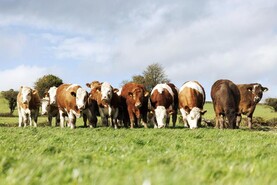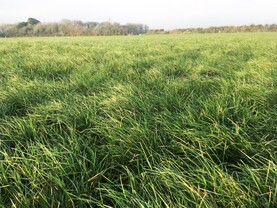When we think of soil fertility and correcting soil nutrients we all think of three things - nitrogen (N), phosphorous (P) and potassium (K). Some people will go one step further and mention lime (pH). But how many of us think about sulphur (S)?
Looking further into the role of S, it is essential for the formation of amino acids
Sulphur is an essential nutrient for grass growth and is closely associated with N uptake and efficiency. As grass grows, both S and N are used together. An S deficiency will therefore decrease N uptake and efficiency and ultimately reduce yield.
Looking further into the role of S, it is essential for the formation of amino acids, the building blocks for proteins, which are needed for growth and development in plants. In that sense, S will also increase the protein and sugar content of grass and particularly in silage.
Results from a grass trial carried out on medium loam soils in the UK showed that in a first-cut silage crop, a 100kg/ha application of straight N delivered a yield of 4.55tDM/ha whilst the addition of 44kg/ha of S and the same quantity of N delivered a yield of 5.85tDM/ha. That’s a 29% increase. These applications also produced an extra 0.8tDM/ha for early grazing.
Was it always a problem?
In the past, S was much more available to grass plants through the atmosphere. Smoke discharges from industrial complexes and domestic fires were the main sources.
Of course, in recent times the burning of fossil fuels and plastics etc has reduced and will continue to do so in an effort to combat global warming.
Depending on animals’ diets, slurry and dung are valuable sources S, but it is present in a form that is mainly unavailable to the grass plant during the growing season
From a grassland perspective, the availability of S is decreasing simultaneously.
Research has shown that in 1960 to 1970, 70-80kg/ha of S was being deposited on land each year. Since the turn of the century, this has dropped to 5kg/ha per year.
Depending on animals’ diets, slurry and dung are valuable sources S, but it is present in a form that is mainly unavailable to the grass plant during the growing season. For example, cattle slurry contains 2.5 units of S per 1,000 gallons, but only 30% is available to the grass plant.
Chemical fertilisers are now the main source of sulphur for grassland.
Symptoms of S deficiency
The recommended amount of sulphur in grass is 0.25-0.4% on a DM basis. The N:S ratio in grass should be no greater than 13:1.
There is no reliable soil test to determine S levels in soils and levels can only be verified through herbage analysis.
An S deficiency is indicated by yellowing of the younger leaves.
Sandy, lighter soils with low organic matter contents are generally more prone to an S deficiency
A deficiency can also be identified through an N deficiency. That is where soils are known to have adequate levels of lime, N, P and K, yet older leaves of the grass plant still turn light green or yellow.
Sandy, lighter soils with low organic matter contents are generally more prone to an S deficiency.
It is estimated that up to 30% of Irish soils would benefit from an application of S. But research shows that S deficiency is not just confined to light textured soils and can occur on heavy textured soils in early spring.
Sulphur application
Where an S deficiency is suspected, it is recommended to apply 20kg/ha (16 units/acre) annually to grazing swards. In silage swards apply 20kg/ha per cut.
The best response to S application is in May and June. Avoid going over recommended application rates as it may trigger a copper or selenium deficiency in livestock.
The best approach is to tie-in sulphur applications with a farm’s overall fertiliser plan. Two of the most common sulphur fertilisers used in Ireland are 18:6:12 + 5% S and CAN (27%N) + 5% S.






 This is a subscriber-only article
This is a subscriber-only article










SHARING OPTIONS: